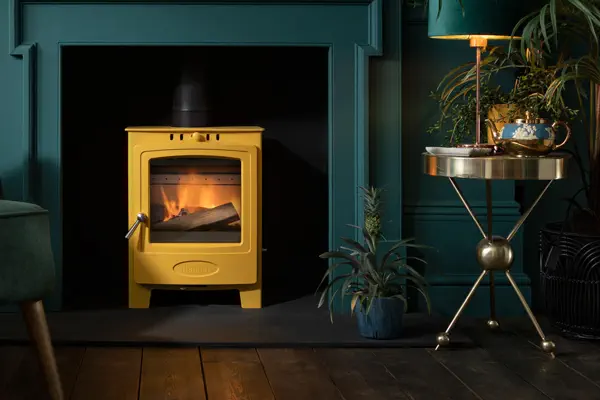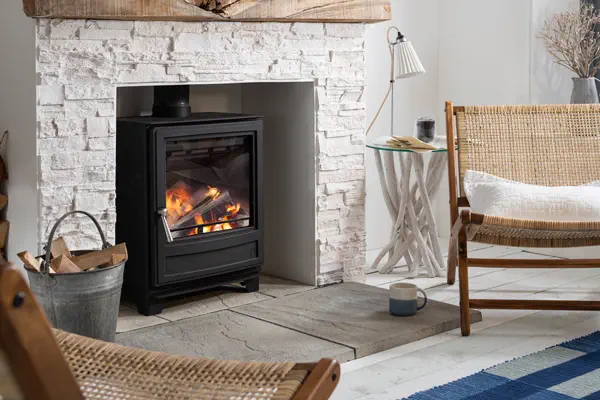What to know before installing a wood burning stove
 Arada M Series 5 Widescreen with glass door option
Arada M Series 5 Widescreen with glass door option
Thinking of installing a wood burning stove this winter?
Before you get started, there are a few things to consider.
You may think it would be too soon for those of you to start thinking about installing a stove ahead of the colder months, however summer is the best time to start planning as there a few steps involved ahead of the stove being up and running!
Try to avoid the typically busy autumn-winter stove installation season to make the jump if you want to be sat in front of a cosy stove with your family this Christmas!
From planning permission and building regulations to stove style and heat output, read on to see our top tips on what to know before choosing a wood burning or multi fuel stove. The below serves as a guide, so we would advise always speaking to a qualified stove installer before any decisions are made.
 Hoxton 7 stove on optional low pedestal
Hoxton 7 stove on optional low pedestal
What type of stove body do I need?
The stove body is based on both preference and what is most suitable for your household. You can choose between either a freestanding stove, which works within a traditional fireplace but also freestanding within a room, or an inset stove body to convert an old, open fireplace.
As well as the function, you can also choose the style and colour. From the contemporary Hoxton stove to the classic Holborn, Arada has a stove style for everyone. In addition, our stoves are available in a wide range of colours.
What size stove do I need?
You need to consider both the physical size of your stove, as well as the heat output it offers to ensure the room is heated efficiently. This will differ depending on the size of the room, how well insulated it is, if you have double glazing, if you have carpet or wood floors – and so on. For example, if you have a well-insulated room with central heating, carpet and double glazing, a 5kW stove should be sufficient. In older, draughty homes with single-glazing and wood floors, you may need a 7kW stove.
Estimate your kW heat output (stove size) needs
Multiply the room volume (width, height and length in metres) then divide the result by 14. This will give you a rough idea of the kW output you need.
Do I need planning permission to install a wood burning stove?
The likelihood is that you won’t need planning permission, however this will vary from household to household, so always speak to a professional installer. Regulations to consider include where the external flue is situated compared to other properties, if your home is listed, if your area has specific regulations for wood burners, where your external flue is compared to a road etc. In many cases, planning permission won’t be required but always speak to a professional before carrying out any work.
 Solution 5 stove in optional Raincoat Yellow
Solution 5 stove in optional Raincoat Yellow
What if I live in a Smoke Control Area?
Smoke Control Orders were put in place across the UK many decades ago, when the increase use of domestic and commercial chimneys were causing severe air quality issues. Over time the number of cities and surrounding areas to become designated Smoke Control Areas will increase. Fortunately, living in a UK Smoke Control Area, does not prevent you from enjoying a solid fuel stove in your home. With our stoves, this simply means that you are required to burn only authorised smokeless fuels that have the 'Ready To Burn' logo.
The other option is to have a DEFRA-exempted stove installed - simply look for the ‘Exempted appliance’ phrase on our stove descriptions – such as the Farringdon Small Eco which is an ‘exempted appliance’.
When installed in Smoke Control Areas, the minimum air control setting on our exempted appliances will have been set up by the installer to meet the requirements of Smoke Control exemption. The modification means that the stove is unable to have its air supply shut down completely when in the minimum air position setting. This prevents the stove from being ‘slumbered’ and creating unburnt emissions which would contravene the purpose of the Smoke Control Area bylaw. Removal or user modification of the installer-fitted air control plate is illegal when the appliance is installed in those areas and doing so may result in prosecution and fine.
To find out if you live in a Smoke Control Area, check online with your local council's Environmental Health Department who will be able to advise you on this.
Do I need a hearth for my wood burner?
A hearth acts as a non-combustible floor for the stove to sit on top of, protecting your floor from the heat or potential embers which can fall from the stove. You must ensure your hearth is made from the correct non-combustible material. From granite and stone to glass and brick, there are a few different options to choose from depending on your style and preference.
 Ecoburn 7 multi fuel stove
Ecoburn 7 multi fuel stove
What is the minimum clearance and size hearth do I need?
When installing a stove, you need to be aware of the clearance to combustible materials which means how much space you need around your stove to meet safety and building regulations. If a combustible material is within an unsafe distance of your stove, this can result in a fire hazard.
The clearance advice will vary depending on the stove model, so it’s best to speak to your fitter who will be able to advise and install the stove correctly. As a general rule, you need:
At least 150mm above the stove (500mm is needed if you have a wooden mantlepiece)
At least 150mm clearance on either side of the stove
At least 255mm clearance at the front of the burner
The hearth should be a minimum of 840x840mm and 12mm thick
The measurement behind your stove will depend on the stove model so ask your fitter
For a stove in a fireplace recess, the above rules apply however there needs to be a ‘constructional hearth’ which projects at least 500mm forward of the front of the stove and 150mm at each side. This floor of the fireplace needs to be at least 250mm thick to meet building regulations.
A rear heat shield is another consideration, which is literally a physical barrier to mitigate heat that is radiated from the rear of the stove. This reduces the distance required between a stove and any non-combustible material, such as brickwork or masonry. Even with a rear heat shield fitted, the stove should not be sited such that it is touching or so close to any non-combustible material as to be impractical or unsafe. A rear heat shield is an optional extra for the majority of our stoves, but some models will have one as standard.
 Holborn Gas stove
Holborn Gas stove
What fire-proofing / heat insulation do I need?
Simply siting a stove alongside a plasterboard wall will be insufficient. The area surrounding the stove – whether that’s on the wall behind a freestanding stove or within a fireplace – needs to be able to withstand high temperatures for safety and to also comply with building regulations.
Vermiculite boards offer essential heat insulation and fireproofing and can be used to line a wall where there is no chimney breast, or the inset of the chimney breastwork well when installed to line the front of plasterboard as a minimum. Vermiculate boards are often used to create a ‘register plate’ for the flue to pass up through the chimney. Vermiculite is heat resistant to about 1100°C and optionally available with pre-cut decorative patterns engraved. Vermiculite boards can also be painted with high-temperature resistant paint to better match the surrounding decor. A high temperature-resistant adhesive will also be needed to bond the boards to surfaces.
Whether you’re starting a renovation or choosing to install a wood burning stove now or later, always discuss the options with your qualified installer who can advise you on the best option for your home.
Related Articles
Choosing a stove
- Choosing an Ecodesign Ready Stove
- The Benefits of An Inset Wood Burning Stove In Your Home
- Why Choose A Freestanding Stove For Your Home?
- 5 Reasons to Buy A Stove in Summer
- No chimney? No problem!
- Contemporary Wood Burning Stoves
- Everything you Need to Know About Electric Fires
- What to know before installing a wood burning stove
27th July, 2023.
